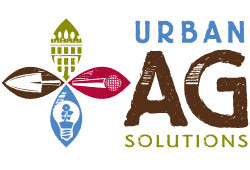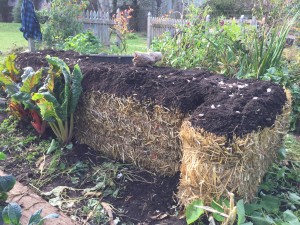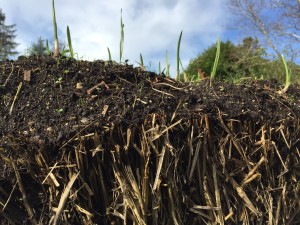Late fall’s the time when straw bales abound, the castoffs of every Harvest Festival and Apple Tasting. While others are busy celebrating the harvest, the astute gardener still thinks about planting and celebrates that what others cast off can become an instant garden treasure.
Drop bales in desired location. Add soil top. Plant. Yes, it’s that easy!
To the modern person, who wouldn’t recognize a hay baler if it ran over him or her, the straw bale is a mere objet d’art, a nod to the landed past, a platform for stacking decorative gourds, and perhaps a temporary bench, yet it is something to be disposed of after the party or the season. A gardener with access to a pickup is thus in an ideal position to contact any and all organizations likely to celebrate the harvest and make a substantial garden swoop in late fall.
The idea of using straw bales as garden beds was recently popularized by Joel Karsten in his book Straw Bale Gardens (also see his website: http://strawbalegardens.com/). He recommends a ten day conditioning period for the bale in which a composting chain reaction is set off by periodic watering and nitrogen fertilization, after which the bale will continue to release its nutrients to veggies planted within it. Bales must be placed with the tubular ends of the stalks up for maximum water absorption. For the fall bale garden, I place the bales similarly, but I skip the conditioning.
My aim in snagging fall bales is to have a place to plant garlic, so I’m not worried about bale activation so much as just getting that garlic up and going. As such, I’m initially using the bale as a kind of raised bed, and so I’ll add an inch or two of garden soil to the top of the bales, then plant my garlic cloves in that. Given that I live in the Pacific Northwest, with its famed abundance of rain in the winter, I’m not worried about the bales being dry. If they start that way, they won’t stay dry for long. As for the nitrogen, cool winter soils don’t give up much nitrogen anyway, so I’ll be following my regular garlic program of applying liquid fish fertilizer in late winter and early spring. Any nitrogen that drips below the garlic root zone will help the straw start to compost. With this fall planting approach, I’ll get the garlic growth I’m used to in soil beds, but I’ll also be getting that bale ready for something to follow that garlic (like kale for next winter!), at which point the straw will have really begun to break down and will be forming a very rich, crumbly compost, yielding benefits for the garden seasons to come.
Fall garlic already shoots skyward. It’s been a warmer-than-average fall.
A couple bale pointers: dry bales are ridiculously easy to toss around, and wet bales are leaden, disc-busting disasters. Places that are giving away their bales may have used them outside and thus they may be wet, so if you are collecting, bring a helper so you don’t wind up mobility-impaired later. Also the thin plastic cording used to bale the bales concentrates a lot of weight on a very small portion of your hand when lifting, usually resulting in a peculiar straw-bale pain. Bring sturdy gloves and save yourself from martyrdom. Finally, straw’s main utility on the farm is as animal bedding; the air in the tubular stalks acts as insulation, and the straws suck up urine and hold it away from the animal. If straw gets wet accidentally, it is farm-useless, so places like horse stables and feed stores may occasionally have some accidentally ruined bales year-round.
So this fall, as you frequent those harvest festivals where straw bales are more part of the decor than part of a land-based lifestyle, take advantage of modernity’s disconnect from its rural past, see those bales as precious garden resources, and come back after the festival’s over for a late fall garden score!


